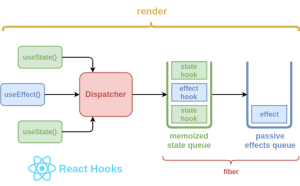React has already revolutionized how we build user interfaces and bring about fundamental changes in the application’s usability. The framework itself is built on some fundamental concepts, including states, props, hooks, among others. These concepts, their usage, and best practices is what we’ll discuss today and how they work together.
React Core Concepts
Core concepts in React are the fundamental principles available in the library. These core concepts enable developers to build dynamic user interfaces. Hence for anyone to master React, an understanding of these concepts is essential.
-
State and Props
State in React is a built-in object that stores data and it can change over time with the component’s lifecycle. State management in React is a crucial activity in building dynamic interfaces, and here are the key strategies to be used for this process;
| Strategy | Description |
| Component State | useState function is used to manage a state in a single component offering a simple way to declare and update the value of that state. |
| Lifting State Up | It’s used when you need to share data between multiple components. This function is used to lift the state to an ancestor component, which helps maintain data consistency. |
| Context API | Used for global state management, Context API is used to share data across different components. This strategy prevents components from passing through props at every level. |
| Redux | Redux brings in a predictable state container and is used for complex applications that have multiple interconnected components and data flows. |
Context API empowers tasks like theme switching and localization. This makes it possible to share data across multiple components without prop drilling. Redux comes into play for state management interactions of complex and data-intensive applications.
When working with React, developers will also have to know about trade-offs between Context API vs Redux. Where Component State is used to manage state within a single component, Context API brings in the required flexibility, but not for complex applications. This is where you can bring in Redux, but it has a learning curve, so tread carefully.
-
Hooks in React
Custom hooks in React are reusable functions storing data on stateful logic within a component. They are useful for code reusability as they help extract common logic and utilize them for separate functions.
Examples of Hooks to create reusable and maintainable React components:
-
- useFetch: Manage asynchronous data fetching.
- useInterval: Execute a function at regular intervals.
- useLocalStorage: Store data in the app’s local storage.
- useForm: Manage hook’s state and validation. Hooks are used for React performance optimization and to enhance application efficiency. They are especially useful when you are building complex applications. But you can optimize app performance using the following Hooks components.
- Deploy useMemo and useCallbacks functions to avoid unnecessary re-renders.
- React offers built-in hooks like useEffect and useState to help you ensure optimal performance while avoiding common pitfalls.
-
Component Structure
Component structure in React refers to the way application components are organized. This structure accounts for code organization and hierarchical relationships between different components, but you must know how to organize and structure components;
-
- Follow the Atomic Design approach where you break components into reusable and smaller units. This includes;
- Atoms – App’s basic building blocks like buttons, inputs, and labels.
- Molecules – The combinations of atoms, including the search bar, navigation menu, etc.
- Organisms – Add all the complex application components here that are built of molecules, including header, footer, etc.
- Creating Reusable and Maintainable Components
Using these components, you can speed up the work, which is especially important in a modern web development environment.
| Component | Usage |
| Props | Giving flexibility and help with passing data to components. |
| State | Manage the component’s state with the useState function. |
| Lifecycle Methods | Add side effects to the app with methods like componentDidMount or componentWillMount. |
| Testing | Write tests for components, checking them for correctness. |
Performance Optimization in React
Performance optimization is critical to building performant and user-centric custom application development services. Even your customers expect the application to be smooth and respond to their commands quickly. Here’s how you can ensure React performance optimization.
-
Virtual DOM (VDOM)
VDOM is the in-memory representation of React UI. You will see React creating a new VDOM tree whenever there’s a change in state or props. As React compares the newly built and previous VDOM, it only implements the changes to update the actual DOM.
As a result, it minimizes unnecessary manipulation and DOM rendering, facilitating better performance. In addition to this, VDOM has also proved useful in cross-browser compatibility. In other words, VDOM ignores the changes in different browsers, ensuring your application performs consistently.
Techniques for Optimizing VDOM Updates
Some important techniques include memorization, where you can employ useMemo and useCallback to memorize values and callbacks. This prevents unwanted code re-rendering and saves developers time and effort.
Another technique we follow is using a unique key prop for each item so that React can identify the changes and reuse the elements. In addition to these two, use shouldComponentUpdate for class components. This function will let you set conditions for rendering the components according to changes in prop or state.
Within VDOM, React and React JS developers have to take help from several tools for performance profiling. These include;
- React DevTools: It’s React’s built-in performance profiler used to analyze the rendering time of components and identify performance issues.
- Browser Developer Tools: Browser tools are available, like Chrome DevTools, Firefox Developer Tools, etc., that you can use to profile network requests and for JavaScript execution.
- Third-Party Libraries: In addition to the above tools, there are several third-party libraries like react-performance-overlay and react-profiler that will prove handy for advanced performance analysis.
-
Memorization in React
Memorization caches the result of a function call to prevent React from processing the same function again. Memorization has two core applications: caching function and eliminating the need for recomputing. The functions used here are;
- useMemo: This function memorizes the result of a function, effectively preventing recalculations.
function ExpensiveCalculation(props) {
const result = useMemo(() => {
// Expensive computation
return someComplexCalculation(props);
}, [props]);
return <div>{result}</div>;
}
- useCallback: Here again, the basic principle is the same, that is, memorizing the callback function; prevents re-rendering of the components used in callback.
function MyComponent({ handleClick }) {
const memoizedHandleClick = useCallback(() => {
// Handle click event
}, []);
return <button onClick={memoizedHandleClick}>Click me</button>;
}
- Where to use the memorization function:
-
- To prevent expensive recomputing.
- Minimize callback processes from scratch in dependencies.
- Prevent overusing memorization and reduce complexity.
-
Lazy Loading in React
It’s another performance optimization technique React developers must know about, Lazy Loading lets you load components, modules, and assets synchronously. Lazy loading of the components has several advantages, including reducing loading time by initializing needed components and saving memory as well.
-
Code Splitting with Dynamic Imports in React
Among different implementation methods, we will focus on dynamic imports for today’s discussion. Dynamic imports allow loading React modules on demand, and here’s a code snippet for your reference.
import React, { lazy, Suspense } from ‘react’;
const LazyComponent = lazy(() => import(‘./LazyComponent’));
function App() {
return (
<Suspense fallback={<div>Loading…</div>}>
<LazyComponent />
</Suspense>
);
}
Using lazy loading in small-sized applications is simple enough. But when it comes to large-scale applications, even the mightiest of React developers must tread carefully.
-
Best Practices to Use Lazy Loading in Large-Scale Applications
-
- Analyze the application to determine components that will be rarely used or can be loaded on demand.
- Use React.Lazy code splitting to optimize component’s bundle size and load times for better performance.
- It’s tempting to use lazy loading across the application but refrain from it. Excessive use of this function can complicate things for you and cook up performance issues.
- To make the implementation of lazy loading easier, you can use tools like Webpack or React libraries from where you can extract lazy and suspense functions.
Conclusion
Building your mastery over these core concepts through best practices and your existing knowledge, you end up making high-quality, scalable, and maintainable web applications. Leveraging custom application development services can further enhance your ability to create tailored solutions for diverse needs. However, it’s also essential to regularly practice using these components and concepts to solidify your understanding.
Angular vs. AngularJS: While both Angular and AngularJS are popular frameworks for building dynamic web applications, Angular is the more advanced version, offering improved performance, a modular architecture, and better tooling compared to the older AngularJS.



















Comments